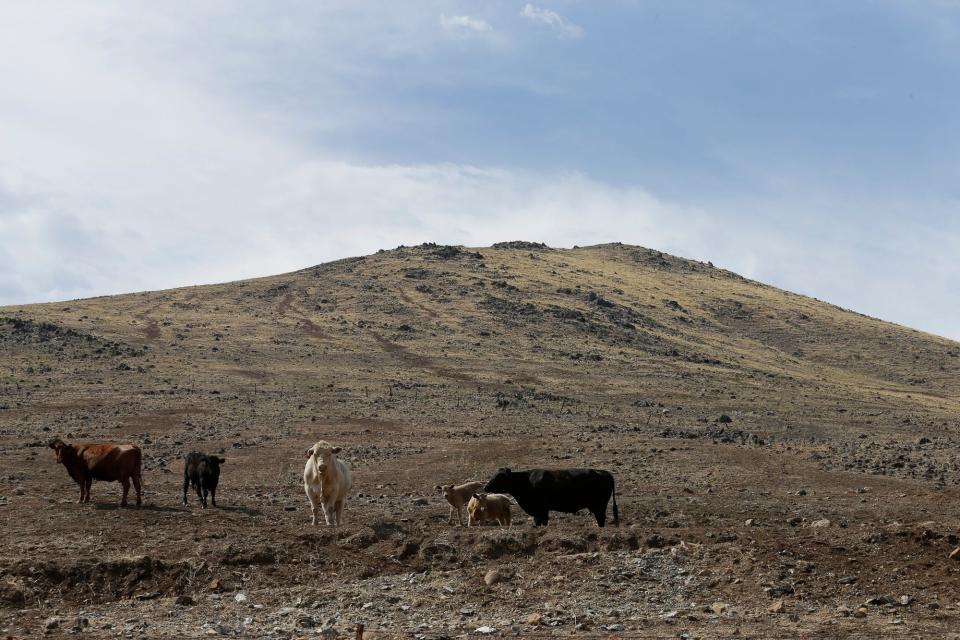In California: Newsom wants $600 stimulus checks for two-thirds of residents

Plus: S.F. teachers union wants seniors back in school — for one day; COVID-19 cases steady; 39 more counties under drought declaration
I'm Winston Gieseke, philanthropy and special sections editor for The Desert Sun in Palm Springs, bringing you the latest headlines on this Monday.
Have a friend who wants California news delivered to their inbox for free? Let them know they can sign up via this link.
California COVID-19 cases holding steady; second-lowest rate of spread in nation
The Golden State reported 13,200 new cases of coronavirus in the week ending Sunday, up slightly from the 13,167 new cases reported the week before.
Weekly case counts rose in 30 counties from the previous week. The worst increases from the prior week's pace were in San Diego, Sacramento and Alameda counties.
California ranked 49th among the states where coronavirus was spreading the fastest on a per-person basis, according to a USA TODAY Network analysis of Johns Hopkins University data. In the latest week, coronavirus cases in the United States decreased 16.9% from the week before, with 286,109 cases reported.
In California, 375 people were reported dead of COVID-19 in the week ending Sunday. In the week before that, 460 people were reported dead.
Could Los Angeles County hit COVID-19 herd immunity by end of July? That's what public health officials said Monday, according to a report in the Los Angeles Times.
FDA gives Pfizer nod to provide COVID-19 vaccine to younger teens

A COVID-19 vaccine made by Pfizer and its German partner, BioNTech, is safe and effective enough to give to younger teens, the Food and Drug Administration said Monday. This means adolescents ages 12 to 15 could qualify for shots within days.
President Joe Biden said last week that 20,000 pharmacy locations are ready to begin vaccinating adolescents once the necessary approvals come through. "And if teens are on the move this summer, they can get their first shot in one place and a second shot elsewhere," he said.
Older teens, ages 16 and 17, have been allowed to get the Pfizer-BioNTech vaccine since it was authorized in December. The other two vaccines authorized for use in the USA, from Moderna and Johnson & Johnson, have not been available to minors because studies are still underway.
“Today’s action allows for a younger population to be protected from COVID-19, bringing us closer to returning to a sense of normalcy and to ending the pandemic," acting FDA Commissioner Janet Woodcock said in a statement Monday. "Parents and guardians can rest assured that the agency undertook a rigorous and thorough review of all available data, as we have with all of our COVID-19 vaccine emergency use authorizations.”
Parents in S.F. furious about seniors going back to school — for one day only
It sounded like great news: over the weekend the teachers union in San Francisco announced that high school seniors will have the opportunity to return to classrooms starting Friday. However, when one reads the plan's fine print, they learn that said students might only be back for one day — and only because of money.
The San Francisco Chronicle reports that some have labeled the move "a blatant money grab": a deal between the school district and the teachers union to bring seniors back “for at least one day before the end of the school year,” so local public schools can qualify for $12 million in state reopening funds; state law requires districts to reopen for in-person instruction for elementary school students as well as students in at least one middle or high school grade.
However, only two high school sites would be available to seniors, meaning most won’t end up at their own school. As of Monday, it was unclear how many students were planning to accept the offer.
Newsom wants to send $600 stimulus checks to two-thirds of Californians

Under a proposal unveiled Monday by Gov. Gavin Newsom, millions of poor and middle-class Californians would get tax rebates of up to $1,100 as part of a broader pandemic recovery plan made possible by an eye-popping $75 billion budget surplus.
Individuals and households making between $30,000 and $75,000 a year would get a $600 payment. All households making up to $75,000 with at least one child, including immigrants in the country illegally who file taxes, would get an extra $500 payment.
“Direct stimulus checks going into people's pockets — that direct relief, that's meaningful," the Democrat said during an event in Oakland to announce the plan.
The massive budget surplus is largely due to taxes paid by rich Californians who generally did well during the pandemic and marks a major turnaround after officials last year said they feared a deficit of more than $50 billion.
A law passed by voters in the 1970s requires the state to give some money back to taxpayers if the surplus hits a certain limit. The state estimates it will be $16 billion over that threshold.
Drought emergency declared in Central Valley

In other Newsom news, the governor on Monday declared a drought emergency in 39 additional California counties, including most of the parched Central Valley and Klamath River area.
The declaration comes amid mounting pressure from lawmakers and growers in the Central Valley, who this year are receiving only 5% of their expected water allocations from the state. Growers say the sharp cutbacks in state and federal water supplies will mean they will suffer huge economic losses and be forced to fallow fields and sell off cattle.
Rachel Becker, writing for CalMatters, reports that a bipartisan group of Central Valley lawmakers wrote to Newsom in April pushing for a statewide emergency that would give the state more flexibility in granting water transfers. They also sought easing of some rules for reservoir releases, which would “allow for more water to go to communities throughout the state.”
The emergency declaration spans 31 counties in the Sacramento and San Joaquin basins, four counties in the Klamath River basin in the far north, and four groundwater-dependent counties in the Tulare Lake basin in the southern San Joaquin Valley.
California man fraudulently got $5M in COVID-19 relief money to buy a Ferrari, Bentley and Lamborghini, authorities say

A Southern California man was arrested on federal charges Friday after federal authorities say he fraudulently obtained millions of dollars in coronavirus relief to buy luxurious cars, take lavish vacations and cover personal expenses.
Mustafa Qadiri, 38, of Irvine, nearly 40 miles southeast of Los Angeles, obtained about $5 million in Payment Protection Program money after claiming to own four businesses in nearby Newport Beach, none of which are in business, according to a federal indictment.
Qadiri submitted claims for All American Lending Inc., All American Capital Holdings Inc., RadMediaLab Inc. and Ad Blot Inc. in May and June 2020 with altered bank accounts, fake federal tax return forms and someone else's identity, according to the U.S. Attorney's Office of California. He then, the indictment says, used the money for vacations, personal expenses, and Ferrari, Bentley and Lamborghini sports cars.
All cars and $2 million from Qadiri's bank account were seized by federal agents when he surrendered himself to authorities Friday morning. He is charged with six counts of money laundering, four counts of bank fraud and wire fraud and one count of aggravated identity theft.
That's all for today. In California is a roundup of news from across USA Today network newsrooms. Also contributing: Los Angeles Times, San Francisco Chronicle. We'll be back in your inbox tomorrow with the latest headlines.
As the philanthropy and special sections editor at The Desert Sun, Winston Gieseke writes about nonprofits, fundraising and people who give back in the Coachella Valley. Reach him at winston.gieseke@desertsun.com.
This article originally appeared on USA TODAY: California: Newsom wants $600 checks for two-thirds of state residents

 Yahoo Movies
Yahoo Movies 